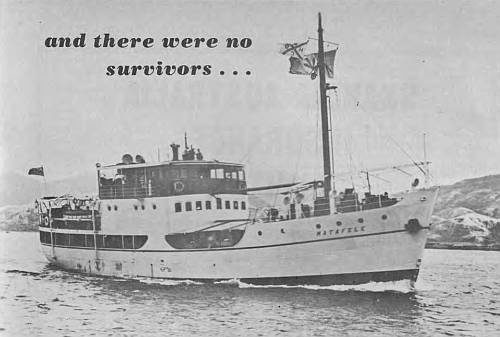- Author
- McMillan, R.
- Subjects
- Ship histories and stories
- Tags
-
- RAN Ships
- HMAS Arunta I, HMAS Matafele, HMAS Potrero, HMAS Basilisk
- Publication
- December 1972 edition of the Naval Historical Review (all rights reserved)

A great deal has been recorded concerning the more famous ships of the Royal Australian Navy which served during the Second World War. Nobody would deny that these vessels and the officers and men who manned them should not be forgotten, but it might be felt that their importance tends to overshadow the many small, lesser known units of the Royal Australian Navy, which due to the passing of time and the lack of publicity are inclined to be forgotten except by those who either served in them or had some other reason to remember.
SUCH A SHIP WAS WAS HMAS MATAFELE and this article is dedicated to the officers, enlisted men and native crew who, whilst serving under the white ensign, lost their lives when this unit of the Royal Australian Navy was sunk.
Matafele was built by Hong Kong and Whompoa Dock Company in 1938. Registered in Hong Kong, she served as part of the Fleet of Burns Philp (South Seas) Ltd., being used in the Pacific Islands as a cargopassenger vessel. Her name derived from a district in Western Samoa where her owners had a trading centre, the literal meaning of the word in the Samoan language being ‘Eye of the Coconut’. A twin screw vessel of some 335 tons (gross), she was ideally suited for trading amongst the reefs and atolls of the south and central Pacific.
During the first years of the Second World War, Matafele carried on her normal trading duties. In January 1942, she arrived at Rabaul to find that the town had already been evacuated and under enemy air attack. Her Master then decided to attempt to sail for Australia. By this time the Japanese were being landed on the beaches. Matafele was not observed by the enemy due to heavy rain squalls and eventually reached Australia via Samarai.
Matafele had up to this time been operating under the authority of the British Ministry of War Transport. In March 1942, immediately after the first Japanese bombing of Darwin, it was decided that in view of the increased enemy activity in the Northern Australian waters and the need for Australia’s foremost outpost on the mainland to be kept supplied, a shuttle service of small ships should operate between Cairns and Darwin. In early March seven small vessels were taken up for this purpose. The Matafele, being one of these vessels, passed to the control of the Australian Commonwealth Shipping Board.
Later in the year she operated in the New Guinea area, being utilised as a store carrier under the operational control of the Naval Officer-in-Charge, New Guinea Commander R. B. A. Hunt, RAN.
On the 29th of August, the Burns Philp motor vessel Malaita, whilst proceeding from Port Moresby to Cairns under the escort of HMAS Arunta, was torpedoed by a Japanese submarine. She soon developed a 10 degree list to starboard but managed to keep afloat. With the aid of HMAS Potrero, Matafele towed Malaita stern first to a safe position where she was able to anchor. In the meantime, Arunta had destroyed the Japanese submarine.
Matafele continued in her role as a stores carrier, being the first ship to run stores beyond Milne Bay after the Japanese landings. At this stage Matafele was not commissioned by the Royal Australian Navy. She retained a mixed crew. However, as Merchant Seamen were discharged they were replaced by Naval Officers and ratings. By December 1942, all the Merchant Service Officers had been replaced by Naval Personnel when fourteen Naval ratings were drafted from HMAS Basilisk (Naval Base, Port Moresby) to supplement the native crew who agreed to continue to serve.
Her Captain was Lt. Commander C. F. Symonds, RN, (emergency list RAN), who was appointed to the Matafele on 14th October 1942, and assumed command of Matafele, commissioning at sea on 1st January 1943. Apparently from some incident connected with his career between wars and after having retired from the Royal Navy, he was known as ‘Sampan Charlie’.
Her first Lieutenant was a man named Gilbert, who pre-war had been a Plantation Manager in the employ of Burns Philp Ltd., stationed in the Kavieng District of New Ireland. He also had a nickname ‘Panapai Jack’, Panapai being the name of the Plantation. Leading Seaman George Arnold was the Leading Seaman rating.
During most of 1943, Matafele continued to run supplies to forward areas. However, for a brief spell later in 1943, she was engaged in buoying channels and erecting navigation markers whilst attached to a Survey group. By this time she was badly in need of a refit and proceeded to Sydney for this purpose, arriving on 16th February 1944.
Matafele began operating once again in March 1944 as a store carrier between Queensland ports and Milne Bay.
Her fateful voyage began on 23rd June 1944, when she left Townsville with 215 tons of stores for Milne Bay. Five days later Matafele was requested by Radio to report her position and the estimated time of arrival at her destination. As no reply was received, a wide search was undertaken by ships and aircraft and despite every effort she was not located. It was believed for some time that she had been a victim of a Japanese submarine but post-war investigation revealed that no enemy submarines were employed in the area in which she disappeared, and it must be assumed that she foundered on 20th June with the loss of her entire complement – four officers, twenty ratings and thirteen Native Seamen.




